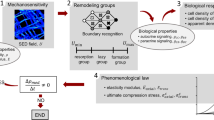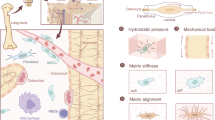Abstract
A new mechanism is presented to explain how increased or decreased mechanical stresses applied to bone are translated into osteoblastic and/or osteoclastic activity. A mechano-chemical hypothesis for bone remodeling induced by mechanical stress is presented in an attempt to explain this phenomenon. Bone responds to mechanical stress by differential growth so as to resist the applied stress; therefore mechanically induced bone remodeling is probably regulated by a negative feedback system. The hypothesis is that a change in the loading of bone results in an altered straining of the hydroxyapatite crystals in bone. This in turn alters the solubility of the crystals, providing the required negative feedback message to the bone cells in the form of a mechanically induced chemical change. The cells then take appropriate action to compensate for the alteration in the localized calcium activity either by building up bone to redistribute an increased stress, or by removing bone which is surplus to the structural needs imposed by a reduced stress. In order to test the hypothesis, synthetic hydroxyapatite crystals were stressed and changes in calcium ion activity were recorded from a divalent cation activity electrode. The results show that a mechanochemical effect can be detected in hydroxyapatite crystals which, when stressed, generate a calcium activity of 9×10−5 moles/l compared to 7×10−5 moles/l when unstressed. The experimental results in this study and evidence from cellular physiology are consistent with the mechanochemical hypothesis proposed here.
Résumé
Un mécanisme nouveau tente d'expliquer comment des forces mécaniques augmentées ou diminuées, appliquées à l'os, sont transformées en activité ostéoblastique et/ou ostéoclastique. Une hypothèse mécano-chimique du remaniement osseux, induit par stress mécanique, est émise pour expliquer ce phénomène. L'os répond á un stress mécanique par une croissance différentielle de façon á résister au stress appliqué: par suite le remaniement osseux induit mécaniquement est probablement sous le controle d'un système “feedback” négatif. L'hypothèse consiste dans le fait qu'un changement de charge au niveau de l'os modifie la tension au niveau des cristaux d'apatite de l'os. Ceci modifie la solubilité des cristaux qui fournit ainsi le message de “feedback” négatif nécessaire aux cellules osseuses, sous la forme d'un changement chimique, indiut par un phénomène mécanique. Les cellules aggissent alors pour compenser les modifications de l'activé calcique localisée soit en construisant de l'os pour redistribuer le stress augmenté, ou en résorbant de l'os, qui est en surplus des besoins structuraux, liés à un stress réduit. Pour tester cette hypothèse, des cristaux d'hydroxyleapatite sont soumis à un stress et des changements d'activité ionique du calcium sont enregistrés à l'aide d'une électrode à cation divalent. Les résultats démontrent qu'un effet mécano-chimique peut etre détecté dans les cristaux d'apatite qui, soumis à un stress, engendrent une activité en calcium de 9×10−5 moles/litres et de 7×10−5 moles/litre, dans des conditions sans stress. Les résultats expérimentaux de cette étude et les données de la physiologie cellulaire s'accordent avec l'hypothèse mécano-chimique proposée.
Zusammenfassung
Um zu erklären, in welcher Weise auf Knochen applizierte, erhöhte oder verminderte mechanische Stresse zu einer Osteoblasten- und/oder Osteoklastenaktivität führen, wird ein neuer Mechanismus vorgeschlagen. Eine mechanochemische Hypothese der Knochenneubildung, verursacht durch mechanische Stresse, wird besprochen, um dieses Phänomen zu erklären. Knochen reagiert auf mechanische Stresse mit differenziertem Wachstum, um damit dem angewandten Stress zu widerstehen; daraus folgt, daß mechanisch induzierte Knochenneubildung vermutlich durch ein negatives Feedback-System reguliert wird. Die Hypothese besteht darin, daß eine Veränderung der Ladung des Knochens eine Veränderung der Spannung der Hydroxyapatitkristalle im Knochen zur Folge hat. Dies wiederum verändert die Löslichkeit der Kristalle und gibt damit die benötigte negative Feedback-Botschaft an die Knochenzellen in Form einer mechanischinduzierten chemischen Umgestaltung weiter. Die Zellen verhalten sich nun dementsprechend, um der Änderung der örtlichen Calciumaktivität entgegenzuwirken; entweder wird Knochengewebe gebildet, um einen erhöhten Stress neu zu verteilen, oder jener Knochenanteil wird beseitigt, der bei reduziertem Stress einen Überschuß der Strukturbedürfnisse darstellt. Um diese Annahme zu überprüfen, wurden synthetische Hydroxyapatitkristalle einem Stress unterworfen, und die Änderung in der Aktivität der Calciumionen wurde mittels einer divalenten Elektrode zur Messung der Kationenaktivität registriert. Die Resultate zeigen, daß ein mechanochemischer Effekt in den Hydroxyapatitkristallen nachgewiesen werden kann, die unter Stress eine Calciumaktivität von 9·10−5 Mol/Liter, dagegen ohne Stress eine solche von 7·10−5 Mol/Liter erzeugen. Die Ergebnisse dieser Untersuchungen einerseits und die Aussagen der Zellenphysiologie andererseits stimmen mit der hier vorgeschlagenen mechanochemischen Hypothese überein.
Similar content being viewed by others
References
Ascenzi, A., Bonucci, E., Checcucci, A.: Studies on the anatomy and function of bone and joints, p. 121–141 (ed. by F. G. Evans), Berlin-Heidelberg-New York: Springer 1966.
Bassett, C. A. L.: Electrical effects in bone. Sci. Amer.213, 18–25 (1965).
Becker, R. O., Bassett, C. A. L., Bachman, C. H.: Bone biodynamics, p. 209–252 (ed. by H. M. Frost). Boston: Little, Brown & Co. 1964.
Bell, G. H.: The biochemistry and physiology of bone, p. 27–49 (ed. by G. H. Bourne). New York: Academic Press Inc. 1956.
Borle, A. B.: Membrane transfer of calcium. Clin. Orthop.52, 267–291 (1967).
Brenner, S. S.: Metal whiskers. Sci. Amer.203, 64–72 (1960).
Carlström, D.: Microhardness measurements on single haversian systems in bone. Experientia (Basel)10, 171 (1954).
Doty, S. B.: Birth defects, Vol. 11, No. 1. Structural organization of the skeleton, p. 45–49. The National Foundation-March of Dimes 1966.
Fleck, G. M.: Equilibria in solution. New York: Holt, Rinehart & Winston, Inc., 1966.
Frost, H. M.: Bone biodynamics, p. 315–333. Boston: Little, Brown & Co. 1964.
Forst, H. M.: Laws of lamellar bone modeling. Instructional Course 1967.
Heilbrunn, L. V.: The dynamics of living protoplasm. New York: Academic Press Inc. 1956.
Johnson, L. C.: Birth Defects, Vol. 11, No. 1. Structural organization of the skeleton, p. 66 to 142. The National Foundation-March of Dimes 1966.
Katchalsky, A., Oplatka, A.: Mechanochemistry. In: Proc. Fourth Intern. Cong. Rheology, p. 73–97 (ed. by E. H. Lee and A. L. Copley). New York: International Pub. Inc. 1965.
Kelly, A.: The nature of composite materials. Sci. Amer.217, 160–176 (1967).
Lange, N. A.: Handbook of chemistry. Sandusky, Ohio: Handbook Publ. Inc. 1952.
Miall, L. M.: A new dictionary of chemistry. New York: Interscience Publ. Inc. 1961.
Neuman, W. F., Neuman, M. W.: The chemical dynamics of bone mineral. Chicago: Chicago Univ. Press 1958.
Orion Research Incorporated: Instruction manual, divalent cation activity electrode model 92–32. Cambridge, Mass. 1966.
Park, H. Z., Talmage, R. V.: Comparison of the effects of calcium and endogenous parathyroid hormone on RNA synthesis in rat bone. Sect. VI, Manuscript No. 26. Houston 1967.
Setlow, R. B., Pollard, E. C.: Molecular biophysics. Reading, Mass.: Addison-Wesley Co., Inc. 1962.
Shamos, M. H., Lavine, L. S.: Physical bases for bio-electric effects in mineralized tissues. Clin. Orthop.35, 177–188 (1964).
Slayter, G.: Two-phase materials. Sci. Amer.206, 124–134 (1962).
Termine, J. D., Posner, A. S.: Amorphous/crystalline interrelationships in bone mineral. Calc. Tiss. Res.1, 8–23 (1967).
Tiselius, A., Hjerten, S., Levin, Ö.: Protein chromatography on calcium phosphate columns. Arch. biochem.65, 132–155 (1956).
Watson, W. F.: Mechanochemistry. New Scient.9, 548–550 (1961).
Author information
Authors and Affiliations
Additional information
This study was supported by U.S.P.H.S. Research Grants 5 R01 HD-02280-02 and HE-02698. The authors gratefully acknowledge financial assistance from the Research Fund of the University of Washington Orthodontic Alumni in preparing the published manuscript and a scientific exhibit based on this research.
Rights and permissions
About this article
Cite this article
Justus, R., Luft, J.H. A mechanochemical hypothesis for bone remodeling induced by mechanical stress. Calc. Tis Res. 5, 222–235 (1970). https://doi.org/10.1007/BF02017551
Received:
Accepted:
Issue Date:
DOI: https://doi.org/10.1007/BF02017551




